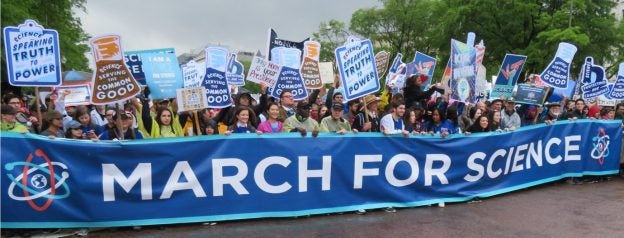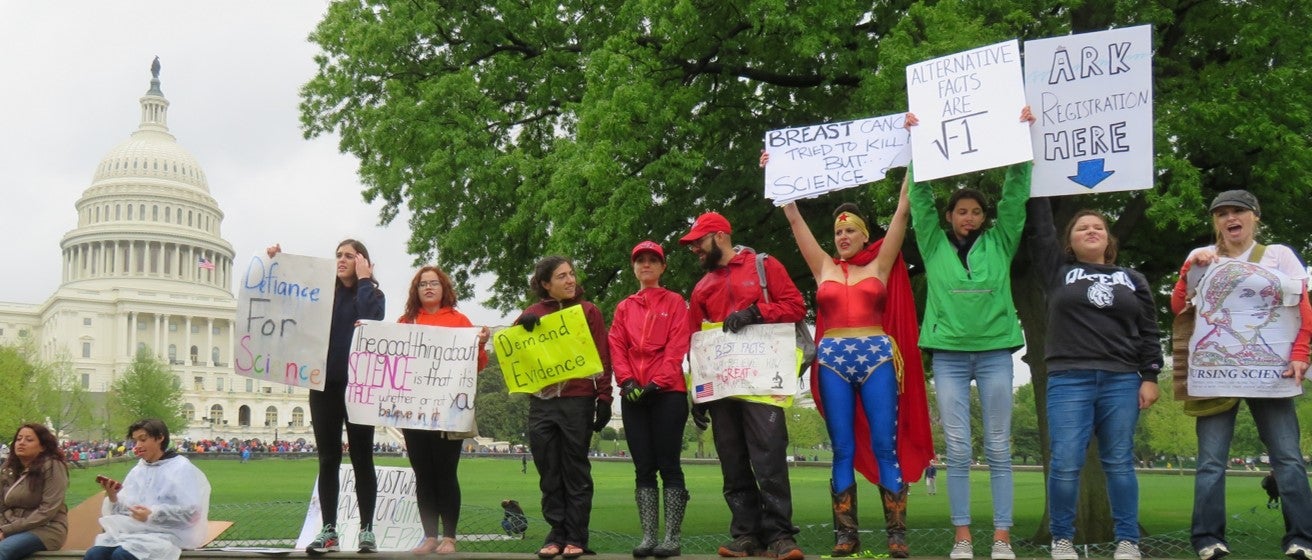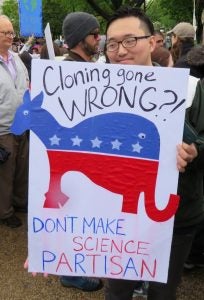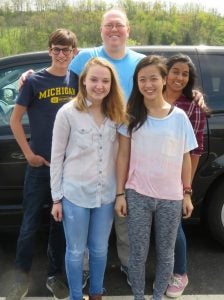Over the next week, LearnSpeakAct will publish a series of three posts on the March for Science, which took place on April 22, 2017.
By Michael Heaney
The presidency of Donald J. Trump has helped to spark a new wave of political discontent across the United States. This discontent is unusual in that it has come so soon in the term of a new president, since it is typical for presidents to experience a time of high approval – a “honeymoon” with the public – during the early months of their first term. Instead, the country has witnessed large and contentious demonstrations against the president’s policies across the nation. These protests have focused on themes such as women’s rights, accepting refugees, the status of immigrants, the President’s failure to release his tax returns to the public, government support for scientific research, and stopping climate change.
Making sense of the formation, nature, logic, and impact of these protests is critical to understanding the functions and dysfunctions of contemporary American democracy. Examining protest opens a window into how citizens react when they are disappointed with the candidates that political parties nominate for office; when they believe that the wrong people win elections; when they do not trust their elected representatives to speak for them; and when they are unable to find rational discourse in the mass media. Under these conditions, social movements attempt to provide an informal alternative to formal institutions in the US political system. Protest is one of their most frequently used tools.
Along these lines, my scholarship focuses on the mobilization of political activists to contest national-level public policies. I research activists, the organizations that nurture them, and how political institutions respond to their advocacy. One important source of data for my research is surveys of activists participating in public demonstrations. In recent months, I have conducted surveys of protesters at the Democratic National Convention, the Republican National Convention, the Presidential Inauguration, the Women’s March on Washington, the March for Life, the Tax March, the March for Science, and the People’s Climate March.
Here I briefly discuss my observations at the March for Science in Washington, DC on April 22, 2017, which I hope provides some insight into how the American political system is functioning in the current period. Given that I only attended the march in Washington, DC, it is important to recognize that there may have been significant differences in the marches that took place in other cities. I make three main points. First, the March for Science is especially interesting because it represents political mobilization on an issue that has not been salient for a long time. Second, the March has political potential in part because it is not closely entangled with other left/liberal movements. Third, the March’s political future is complicated by ties between its activists and the Democratic Party to the exclusion of conservative activists.
Funding Science is Salient Again
On April 22, 2017, over 100,000 people marched in the rain from the Washington Monument to the US Capitol to express the position that government should fund scientific research, that something should be done to stop climate change, and positions on many other issues. Hundreds of solidarity marches took place in other cities. While this event was not the largest demonstration in recent years, it nonetheless reflects a massive and politically consequential mobilization.
The size and reach of the March for Science is notable because government funding for science has not been a highly controversial issue for much of the last century. Of course, there are various aspects of scientific research that have generated controversy – such as stem cell research – but there has generally been a broad, bipartisan consensus that government funding for science is a good thing. Recent attacks by Republicans in Congress and the Trump Administration are at odds with this century-long consensus.
To state that science funding has not been politically controversial, however, is not to state that it cannot be or should not be controversial. Indeed, the project to induce greater government reliance on science was part of a push by progressive politicians in the late nineteenth and early twentieth centuries. For example, the early impetus to use scientific research to boost agricultural productivity was part of this progressive initiative.
Just as funding science was once on the agenda of progressive politicians, it seems that it is again. Mobilizations like the March for Science, as well as lobbying and electoral politicking, will likely be necessary to continue government expenditures in this area at levels that have become customary.
Pro-Science is an Independent Movement
A striking feature of the March for Science is that it did not appear to be closely entangled with other left/liberal social movements. As I stood in the middle of Constitution Avenue while the march passed me by, I saw activists carrying many signs on scientific themes. Messages addressed climate change, the value of scientific research to advancing health care (e.g., eradicating polio), and other myriad contributions of science to the public good. There were very few signs that were off topic or somewhat far afield, such as “Feminists against Trump.”
It is typical that aligned groups attempt to coopt left/liberal protests. For example, antiwar rallies after 9/11 were populated by advocates for freedom in Palestine, socialism in the United States, and health care for all. The fact that the March for Science did not face this type of “invasion” from aligned movements is a good sign that it is entering the political fray with a fair degree of autonomy. As a result, the leaders of this community still have the opportunity to act creatively in terms of how they inject themselves into the political process.
The March for Science demonstrated that there is extensive, grassroots support for science funding that is unencumbered by complex alliances and coalitions. The pro-science movement is thus freed from the need to reciprocate in supporting other liberal causes. These factors help to keep the door open in generating support from Republicans, Democrats, and people of all political persuasions.
Democrats and Other Leftists Dominated the March
My principal purpose for attending the March for Science was to conduct surveys of the activists in attendance. I was assisted in this work by four current LSA undergraduate students (Will Sollish, Katarina Nehrkorn, Yuka Naya, and Kiki Bayen), one recent Michigan graduate (Aubrey O’Neal), and 17 individuals from the local DC area. Using a method of randomly selecting participants in protests developed by Fabio Rojas and myself (see our book, Party in the Street: The Antiwar Movement and the Democratic Party after 9/11, Cambridge University Press, 2015), the students were able to collect 447 surveys at the march. Our response rate was 88 percent. A story with greater detail about our work at the March appears in Science magazine.
While I have not yet been able to process all of the data collected at the march, I do have results on the question of the partisanship of the marchers. In the following table, I present the results alongside results of the same question asked at the Women’s March on Washington (April 22, 2017).
| Partisan Leaning | March for Science | Women’s March |
| Strong Republican | 0.00% | 0.67% |
| Not very strong Republican | 0.26% | 1.01% |
| Independent who leans Republican | 1.80% | 0.34% |
| Independent | 7.46% | 3.37% |
| Independent who leans Democrat | 30.08% | 26.26% |
| Not very strong Democrat | 8.74% | 8.42% |
| Strong Democrat | 46.02% | 50.17% |
| Other (e.g., Socialist, Progressive, Libertarian) | 5.66% | 9.76% |
| Number of Valid Responses | 389 | 297 |
As is immediately apparent, the Women’s March was slightly more Democratic in orientation than was the March for Science. The difference between these distributions is statistically significant. However, both marches leaned strongly in the Democratic/left direction. There were very few conservatives or Republicans at either of these events.
There are likely Republicans and conservatives who support government funding for science. Their lack of participation in this event is probably due to several factors. First, they may have anticipated that the demonstration would consist mostly of liberals, and they preferred not to join in with this crowd. Second, they may want the government to fund science, but may not want to be disloyal to a president whom they support. Third, they may prefer other tactics to protest; for example, they may be more amenable to meeting privately with lawmakers or writing letters to Congress.
A major challenge for pro-science forces is to find ways to engage Republicans in their movement. Unless they do so, elected officials in the Republican Party may be inclined to be dismissive of the March for Science. Thus, creating greater political balance among those whom they mobilize may be key to having the political impact that they are seeking to have.
Conclusion
Americans tend to fetishize voting. From this viewpoint, casting a vote is considered the mark of doing one’s civic duty. Those who vote are good citizens; nonvoters are a plague on the republic.
It is a mistake, however, to reduce American democracy to the limited choices offered at the voting booth. Activism and protest are ways for citizens to raise their voices throughout the year, regardless of whether or not elections are taking place. Social movements seek to galvanize citizens to act in ways that counter the goals of political parties, Congress, the president, and other political institutions. They provide an informal correction to some of the weaknesses in the formal American political system.
The March for Science is but one example of citizens seeking to redress their grievances with government. Yet it provides a significant example of what real citizen engagement looks like. It is likely that the coming months and years will offer more examples of similar efforts, as opposition to the Trump Administration shows no sign of damping down any time soon. It is imperative that social scientists continue to play a role in investigating how this story unfolds.
—
Michael T. Heaney is Assistant Professor of Organizational Studies and Political Science at the University of Michigan. Along with Melody Shemtov and Marco Roldán, he is creator, producer, and writer of a new documentary film, The Activists: War, Peace, and Politics in the Streets, available for purchase through Bullfrog Films.





